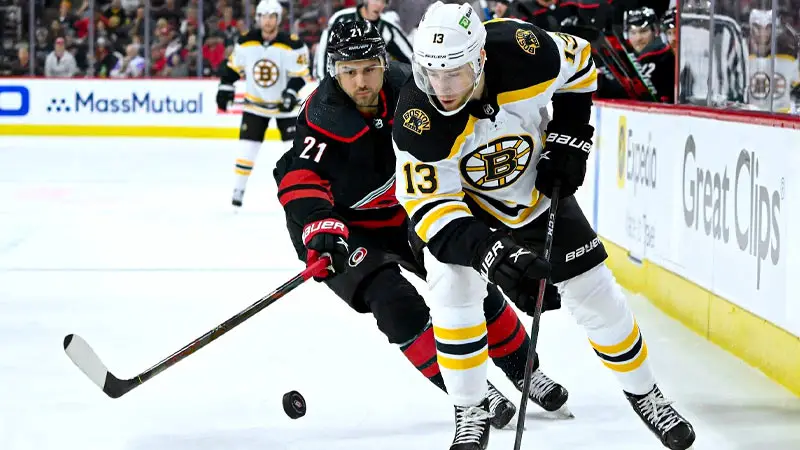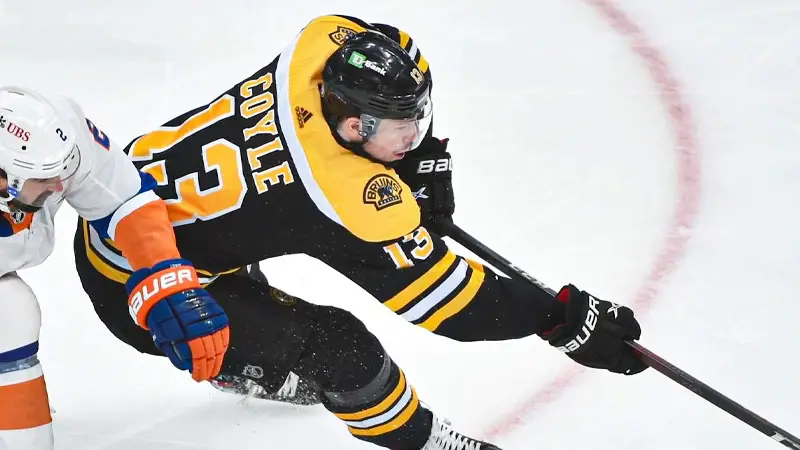Charlie Coyle, a formidable force in the world of professional hockey, has garnered attention not just for his skill on the ice, but also for his tendency to break hockey sticks.
This phenomenon prompts an exploration into the factors contributing to the recurrent breakages.
Whether it be the result of his robust playing style, specific preferences in stick materials, or external elements, understanding the reasons behind Charlie Coyle’s frequent stick breakages offers insights into the intricate relationship between a player, their playing style.
Delving into this intriguing aspect sheds light on the challenges elite athletes face in optimizing performance and equipment durability.
Who Is Charlie Coyle?
Charlie Coyle is an American professional ice hockey player, born on March 2, 1992. He plays as a forward for the Boston Bruins in the National Hockey League (NHL).
Coyle began his NHL career with the Minnesota Wild in 2012 before joining the Bruins in a trade during the 2018-2019 season. Known for his versatility, Coyle is valued for his ability to play both center and right-wing positions.
He has represented the United States in international competitions, including the IIHF World Championship. Coyle is recognized for his scoring ability, physical presence, and reliable two-way play on the ice.
Why Does Charlie Coyle Break So Many Hockey Sticks?
Charlie Coyle broke 67 hockey sticks in the 2019-20 season, which was the most among all NHL players. He also broke 12 sticks in the 2020 playoffs, which was the second-most behind Nathan MacKinnon.
He often engages in stick-on-stick contact with opposing players, which can cause damage to his blade or shaft. Coyle also has a powerful shot, which puts a lot of stress on his stick.
Playing Style
Some players have a more aggressive or physical playing style, leading them to take harder shots, deliver more checks, or engage in intense battles along the boards.
This increased physicality can put additional stress on the hockey stick, making it more prone to breakage.
Stick Material and Design
The type of material a hockey stick is made from and its design can impact its durability.
While many sticks are designed to be lightweight for improved performance, this can sometimes come at the expense of durability. Players who use high-performance sticks may find them more prone to breaking.
Stick Flex
The flex rating of a hockey stick refers to how much it bends under pressure. Some players prefer a lower flex for increased shot power, but this can make the stick more susceptible to breaking, especially if the player is heavy-handed with their shots.
Temperature and Humidity
Environmental conditions can affect the integrity of hockey sticks. Extreme temperatures, combined with changes in humidity, can impact the flexibility and durability of the stick, making it more likely to break.
Manufacturing Defects
Occasionally, sticks may have manufacturing defects that make them more susceptible to breaking. This could be a flaw in the material or the construction process, leading to premature failure.
Bad Luck
In some cases, stick breakage may simply be a matter of bad luck. A player might hit an opponent’s stick in just the wrong way, or the stick may weaken over time through regular use.
Does Breaking So Many Hockey Sticks Affect Charlie Coyle’s Performance?

Charlie Coyle breaking an unusually high number of hockey sticks. However, if a player consistently experiences stick breakage, it can potentially impact their performance in several ways.
Disruption of Play
A broken stick can disrupt the flow of the game for a player. It may lead to a loss of possession, an inability to take a shot, or difficulties in making plays, which could impact Coyle’s overall performance on the ice.
Adjustment Period
When a player switches to a new stick mid-game or mid-practice, there might be an adjustment period required to get used to the feel and performance of the new stick.
This adjustment could affect shooting accuracy, passing, and overall comfort on the ice.
Psychological Impact
Frequent stick breakage might affect a player’s confidence. If a player becomes hesitant or overly cautious due to concerns about stick durability, it could influence their decision-making and aggressiveness on the ice.
Equipment Preferences
Hockey players often develop preferences for specific equipment, including sticks.
When a player is consistently breaking sticks, they may need to reevaluate their choice of sticks, considering factors such as flex, material, and design to find a more durable option that suits their playing style.
Financial Impact
Frequent stick breakage can have financial implications, as hockey sticks, especially high-performance ones, can be expensive.
When a player consistently goes through sticks at a higher rate, it may increase the cost of maintaining their equipment.
Team Dynamics
In team sports like hockey, individual performance is interconnected with the overall dynamics of the team.
Stick breakage, especially at critical moments, could impact team strategies, power plays, or penalty kills, potentially affecting the team’s overall success.
Injury Risk
A broken stick can pose an injury risk, not only to the player with the broken stick but also to teammates and opponents on the ice.
The splintered pieces of a broken stick can be sharp and cause injuries during gameplay, emphasizing the importance of maintaining equipment integrity for the safety of all players.
How Does Charlie Coyle Deal With Breaking So Many Hockey Sticks?

Charlie Coyle has learned to cope with breaking so many hockey sticks over the years. He always carries several backup sticks with him on the bench and in the locker room, and he switches them frequently during games.
He also has a good relationship with his equipment manager, who helps him order and customize his sticks from his supplier, Warrior Hockey.
Equipment Adjustments
Players often work closely with equipment manufacturers and their team’s equipment staff to find sticks that balance performance with durability.
They may experiment with different materials, flex ratings, and stick designs to minimize breakage.
Quick Changes
In the event of a broken stick during a game or practice, players like Charlie Coyle likely have a quick and efficient process for retrieving a replacement stick.
They might have multiple sticks ready on the bench, ensuring minimal disruption to their gameplay.
Mental Adaptation
Over time, players develop mental resilience and adaptability. If breaking sticks becomes a recurring issue, players like Coyle may mentally adjust their playstyle, becoming more mindful of stick usage to reduce the likelihood of breakage during critical moments.
On-Ice Awareness
Increased awareness of potential stress points during gameplay can help players like Coyle avoid situations that are more likely to result in stick breakage.
This heightened awareness may come from experience and a deep understanding of their playing style.
Collaboration with Equipment Staff
Professional players collaborate closely with their team’s equipment staff. This collaboration involves ongoing communication about stick preferences, potential durability issues, and adjustments needed to optimize equipment performance.
Skill Development
Some players work on refining their skills to reduce the impact on their sticks. For instance, improving shooting technique and accuracy can minimize the risk of stick-breaking, especially if the breakage is associated with the force and mechanics of shots.
FAQs
Why does Charlie Coyle break so many hockey sticks?
While specific reasons may vary, factors such as playing style, stick material, and environmental conditions can contribute.
Does Charlie Coyle use a particular type of hockey stick?
Coyle’s stick choice may influence its durability. Players often experiment with stick materials, flex ratings, and designs to find the right balance between performance and resilience, aiming to reduce the likelihood of breakage.
How does stick breakage affect Charlie Coyle’s game?
Stick breakage can disrupt gameplay, affecting Coyle’s ability to shoot, pass, and make plays.
Has Charlie Coyle taken steps to minimize stick breakage?
Professional players often collaborate closely with equipment staff, making adjustments to stick preferences and experimenting with different options.
Is stick breakage a common issue among hockey players?
Yes, stick breakage is not uncommon in hockey, especially among players with aggressive playing styles.
To Recap
Charlie Coyle’s propensity for breaking hockey sticks likely results from a combination of his aggressive playing style, stick material choices, and the intense physical demands of professional hockey.
While specific details may vary, professional players like Coyle constantly navigate the delicate balance between performance and durability in their equipment.
Collaborating with equipment staff, adapting playing techniques, and staying vigilant about stick stress points are essential strategies.
Coyle’s ability to manage and overcome stick breakages reflects not only his resilience on the ice but also the ongoing evolution and refinement of a player’s relationship with their equipment in the dynamic world of professional hockey.








James Felix